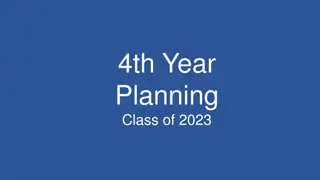Enhancing Individualized Learning Plans in Pediatric Residency Training
The study focuses on whether faculty development intervention can enhance the effectiveness of Individualized Learning Plans (ILPs) in pediatric residency training. It aims to improve faculty and trainee experiences with ILPs, including increasing faculty perception of ILP importance, self-directed learning readiness, self-efficacy in facilitating ILPs, and resident valuing of ILP usefulness. The research plan involves faculty intervention based on adult learning theory, with survey instruments measuring course valuing, self-directed learning readiness, and faculty self-efficacy.
Download Presentation

Please find below an Image/Link to download the presentation.
The content on the website is provided AS IS for your information and personal use only. It may not be sold, licensed, or shared on other websites without obtaining consent from the author.If you encounter any issues during the download, it is possible that the publisher has removed the file from their server.
You are allowed to download the files provided on this website for personal or commercial use, subject to the condition that they are used lawfully. All files are the property of their respective owners.
The content on the website is provided AS IS for your information and personal use only. It may not be sold, licensed, or shared on other websites without obtaining consent from the author.
E N D
Presentation Transcript
Can Faculty Development Enhance the Effectiveness of Individualized Learning Plans in Pediatric Residency Training? Ann E. Burke, MD Assistant Professor, Pediatrics Residency Program Director
What is an Individualized Learning Plan?
What is an ILP? Loosely defined as a learning contract First Proposed in Medical Literature in Britain in the late 1990 s Defined in Pediatrics as: Self-assessment exercise Addressing areas of weakness with objectives, accompanied by strategies Faculty who acts as a facilitator
What is an ILP? Explicitly aimed at improving and enhancing self-directed learning It is very difficult to measure self- directed learning improvement It is very difficult to find validated and reliable tools. But we are giving this a try
Background Increased emphasis on Self-Directed Learning in Graduate Medical Education Pediatric RRC Mandates Individualized Learning Plans (ILP) as of 2006 Many faculty (including program directors) have never done an ILP There is a paucity of information about ILPs in general There is no information about faculty facilitation of trainee ILPs.
Purpose/Aims of Project Overall aim: to determine if a faculty development intervention enhances faculty and trainees experiences in using ILPs as an educational tool. Determine if the intervention increases: 1. Faculty perception of the importance of ILPs 2. Faculty self-directed learning readiness 3. Faculty self-efficacy with facilitating ILPs 4. Resident Valuing of ILP usefulness
Research Plan: 22 Wright State Faculty 42 Wright State Pediatric Residents Faculty intervention Adult learning theory: 1) reading/self- directed learning, 2) creating and ILP, 3) discussion group Survey Instruments/Outcome measures Course Valuing Inventory: perceived meaningfulness of a course to learner Self Directed Learning Readiness Scale: learning readiness/self direction Faculty Self Efficacy Scale: confidence in one s own ability regarding ILPs
Research Plan/Design Baseline (pre-intervention) for faculty: SDLRS, Faculty Self Efficacy Scale Faculty randomized into two groups: Control and Faculty Development Intervention Baseline for residents: SDLRS Two facilitations of resident ILPs (q 6 months)
Research Plan/Design Outcomes: Faculty will do SDLRS, Faculty Self Efficacy Scale and Course Valuing Inventory Residents will do SDLRS and Course Valuing Inventory
Evaluation Methods Characteristics of faculty (age, specialty, gender) will be compared between the faculty groups using chi-square or two-sample t tests. SDLRS and Faculty Self Efficacy Scale will be analyzed by comparing differences in scores between the two groups and changes in scores over time with two-way ANOVA with repeated measures The Course Valuing Inventory will be compared between groups with t tests.
Evaluation Methods Identical analyses will be performed on data collected from residents. Residents who are facilitated by an intervention group faculty will be considered to have received the benefit of the faculty development. USMLE step two scores and post-graduate level will also be compared between the two groups. 80% Power to detect 10 point difference between groups for SDLRS, 9 points on CVI
Faculty (n=22) Residents (n=42) Current Status Randomization Faculty (n=11) SDLRS Self-Efficacy Scale Faculty (n=11) SDLRS Self-Efficacy Scale 1) Data collection starts on June 2007 2) IRB approval 3) Special Projects Grant (APPD) 4) Faculty volunteered 5) Will utilize Pedialink 6) Faculty Intervention developed Residents (n=21) SDLRS Residents (n=21) SDLRS Faculty Development Intervention Both Faculty Groups Facilitate 2 ILPs by Residents Control Faculty (n=11) SDLRS Self-Efficacy Scale CVI Faculty (n=11) SDLRS Self-Efficacy Scale CVI Residents (n=21) SDLRS CVI Residents (n=21) SDLRS CVI
Barriers Finding the validated tools Figuring out the outcome measures Applying for IRB approval Explaining to people what an ILP is!
Good Stuff Interesting Finding out answers to questions Becoming well read on a topic Not being scared of the IRB And last but certainly not least
Getting to work with and learn from ADRIENNE























